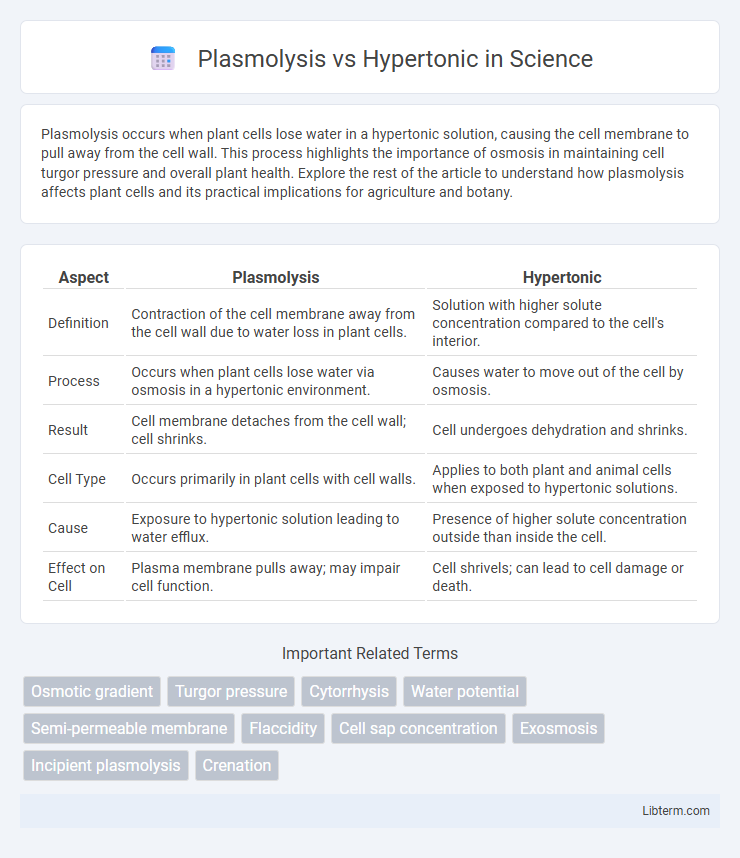Plasmolysis occurs when plant cells lose water in a hypertonic solution, causing the cell membrane to pull away from the cell wall. This process highlights the importance of osmosis in maintaining cell turgor pressure and overall plant health. Explore the rest of the article to understand how plasmolysis affects plant cells and its practical implications for agriculture and botany.
Table of Comparison
| Aspect | Plasmolysis | Hypertonic |
|---|---|---|
| Definition | Contraction of the cell membrane away from the cell wall due to water loss in plant cells. | Solution with higher solute concentration compared to the cell's interior. |
| Process | Occurs when plant cells lose water via osmosis in a hypertonic environment. | Causes water to move out of the cell by osmosis. |
| Result | Cell membrane detaches from the cell wall; cell shrinks. | Cell undergoes dehydration and shrinks. |
| Cell Type | Occurs primarily in plant cells with cell walls. | Applies to both plant and animal cells when exposed to hypertonic solutions. |
| Cause | Exposure to hypertonic solution leading to water efflux. | Presence of higher solute concentration outside than inside the cell. |
| Effect on Cell | Plasma membrane pulls away; may impair cell function. | Cell shrivels; can lead to cell damage or death. |
Introduction to Plasmolysis and Hypertonic Solutions
Plasmolysis occurs when plant cells are placed in hypertonic solutions, causing water to move out of the cell by osmosis, leading to the shrinking of the cytoplasm away from the cell wall. Hypertonic solutions have higher solute concentrations compared to the cell's internal environment, driving this osmotic water loss. Understanding the interaction between plasmolysis and hypertonic environments is crucial for studying plant cell behavior under stress conditions.
Defining Plasmolysis: Key Concepts
Plasmolysis is the process where plant cells lose water in a hypertonic solution, causing the cell membrane to detach from the cell wall. This occurs when the external solution has a higher solute concentration than the cell's cytoplasm, leading to water movement out of the cell via osmosis. Understanding plasmolysis involves recognizing its role in plant cell shrinkage and the effects of hypertonic environments on cellular function.
What Is a Hypertonic Solution?
A hypertonic solution contains a higher concentration of solutes compared to the inside of a cell, causing water to move out of the cell by osmosis. This outward movement of water leads to plasmolysis, where the cell membrane contracts away from the cell wall in plant cells. Understanding the role of hypertonic solutions is crucial in fields such as cell biology and medicine for controlling cell volume and osmotic balance.
The Science Behind Plasmolysis
Plasmolysis occurs when a plant cell is placed in a hypertonic solution, causing water to move out of the cell via osmosis, leading to the shrinking of the cytoplasm away from the cell wall. The hypertonic environment creates an osmotic gradient where the external solute concentration is higher than inside the cell, driving water efflux. This process illustrates the fundamental principles of osmotic pressure and cell membrane permeability in plant cells under stress conditions.
How Hypertonic Solutions Cause Plasmolysis
Hypertonic solutions have a higher solute concentration than the cell's cytoplasm, causing water to move out of the cell by osmosis. This water loss leads to plasmolysis, where the cell membrane shrinks away from the cell wall in plant cells, resulting in cellular dehydration and structural collapse. The osmotic pressure difference between the hypertonic environment and the cell interior drives this critical process of plasmolysis.
Cellular Effects: Plasmolysis vs. Hypertonic Environments
Plasmolysis occurs when plant cells lose water in hypertonic environments, causing the cell membrane to retract from the cell wall due to water efflux. Hypertonic conditions create an osmotic gradient that drives water out of the cell, leading to cell shrinkage and decreased turgor pressure. This cellular dehydration impairs metabolic functions and can result in irreversible damage if the osmotic stress is prolonged.
Differences Between Plasmolysis and Hypertonic Conditions
Plasmolysis occurs when a plant cell is placed in a hypertonic solution, causing water to move out of the cell and the cell membrane to pull away from the cell wall. Hypertonic conditions refer to the external solution having a higher solute concentration than the cell's cytoplasm, leading to osmotic water loss. The key difference lies in plasmolysis describing the cellular response, while hypertonic condition denotes the environmental state causing that response.
Visual Indicators of Plasmolysis in Plant Cells
Plasmolysis in plant cells occurs when the cell membrane pulls away from the cell wall due to water loss in a hypertonic solution, causing visible shrinkage of the cytoplasm. Key visual indicators include the retraction of the protoplast from the cell wall and the formation of gaps between the cell wall and membrane, often observed under a microscope. These signs distinctly differentiate plasmolysis from other cellular responses to hypertonic environments.
Real-World Applications and Importance
Plasmolysis occurs when plant cells lose water in a hypertonic solution, causing the cell membrane to pull away from the cell wall, which is crucial for understanding agricultural practices involving soil salinity management. Hypertonic environments are utilized in food preservation methods, such as curing and pickling, where high solute concentrations inhibit microbial growth by inducing plasmolysis in bacteria. In medical treatments, hypertonic saline solutions are applied to reduce cerebral edema by drawing water out of swollen brain cells through osmotic pressure, highlighting the clinical relevance of osmotic balance.
Conclusion: Understanding Plasmolysis and Hypertonic Interactions
Plasmolysis occurs when plant cells lose water in a hypertonic solution, causing the cell membrane to pull away from the cell wall due to water efflux. Hypertonic environments have a higher solute concentration outside the cell, driving water out and resulting in cell shrinkage or plasmolysis. Understanding these interactions is crucial for fields like botany and agriculture, as they influence plant cell turgidity and overall health under stress conditions.
Plasmolysis Infographic

 libterm.com
libterm.com